Last Updated on April 26, 2023
This sheepdog breed boasts a majestic white coat and protective nature. Not to mention its regal presence. It’s easy to see what makes the Hungarian Kuvasz (pronounced “koo-vahz”) such an excellent addition to a home.
In this article, we explore all the qualities of this breed. So you will know exactly what to expect from your future best friend.
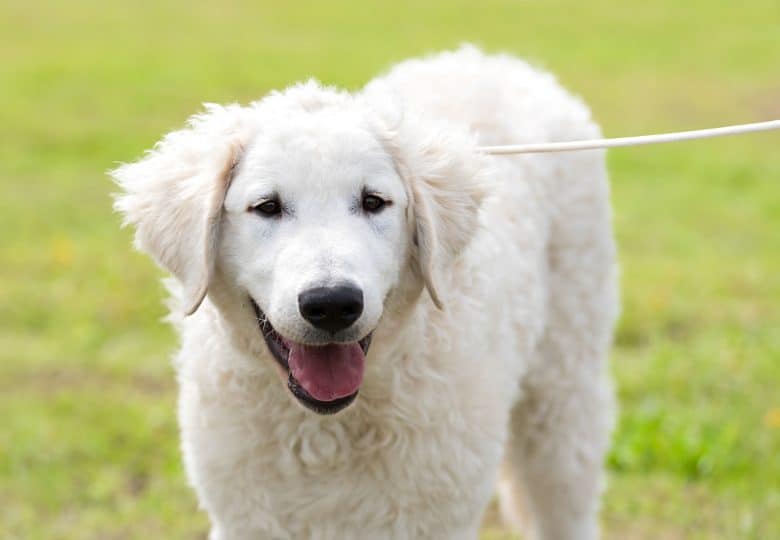
Quick Navigation
- 1 Where does the Kuvasz dog breed come from?
- 2 What does a Kuvasz look like?
- 3 What to expect from a Hungarian Kuvasz’s temperament and personality
- 4 How to take care of your Kuvasz
- 5 Health issues your Kuvasz may suffer from
- 6 How much does a Kuvasz puppy cost?
- 7 The Kuvasz VS Great Pyrenees
- 8 Who should get a Kuvasz dog?
- 9 Further reading: Similar dog breeds to Kuvasz
Where does the Kuvasz dog breed come from?
We can trace the Kuvasz back to historic Hungarian texts. They were excellent livestock guardians and guard dogs even capable of hunting large game.
Sumerian herdsmen domesticated this ancient breed almost 8000 years ago. It was through this connection that they made their way to present-day Hungary.
Some sources state that their family goes back to ancient Turkey and Tibet. And that they came to Hungary by way of the Magyar tribes when they invaded the nation.
The name ‘Kuvasz’ comes from the Turkish word ‘kawasz’, which means ‘armed guard of the nobility’. Royals and nobles kept them during the Middle Ages to serve as guard dogs and flock guards.
In the late 15th century, King Matthias Corvinus of Hungary stopped anyone who wasn’t noble from owning a Kuvasz.
Like many other dog breeds, the Kuvaszok almost went extinct as a result of World War II. But they soon bounced back and became popular.
In the 1930s, the Kuvasz’s reputation as a working dog shifted. They became the fashion dog for breeders and dog enthusiasts. This spread across the breed’s native country and Western Europe.
Today, they are one of the oldest and most popular amongst the native Hungarian breeds, including in the United States.
According to the AKC, or the American Kennel Club, this breed ranks at the 144th position in popularity.
If you’d like more information about their powerful legacy, take a look at the video down below:
While the Kuvasz, Maremma Sheepdog, and Great Pyrenees do have a few notable similarities, they are not the same dog breed.
And there are various traits that help distinguish one from the other, which we’ll go into further below.
What does a Kuvasz look like?
The Kuvasz is a large dog with a sturdy, well-muscled build.
The Kuvasz’s head is wedge-shaped with an elongated skull. It’s typically half as wide as it is long. It also has a slight, refined stop with a black nose.
Its ears are thick, v-shaped, and rounded at the tip. They are set back between the level of the eye and the top of the head.
Their ears don’t protrude above the head. Their eyes are set well apart and a little below the plane of their muzzle, slightly slanted. They are almond-shaped and dark brown in color.
Overall, the Kuvasz’s body proportions are muscular and well-balanced. Its neck is medium-length, arched at the crest, and muscular with no dewlap.
The back is medium in length and straight, solid, and broad. Its croup is slightly sloping with and the loin is taut, short, and muscular.
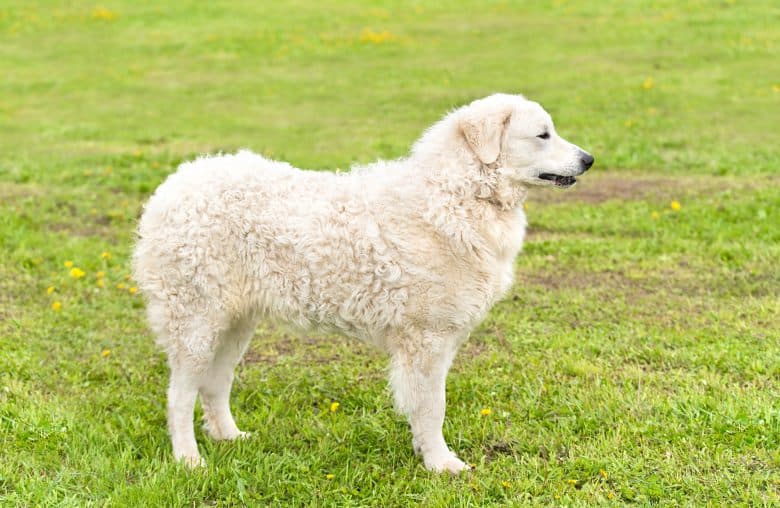
The forechest is well-developed and protrudes slightly in front of the shoulders with the stomach being well tucked up. The Kuvasz carries its tail low, but it may become slightly raised to loin-level when excited.
The Kuvasz’s forequarters comprise long, muscular shoulders. The topline withers are higher than the back.
Its elbows are neither in nor out, with its legs straight and well-muscled and its feet well-padded. The pads and nails are usually dark in color, with some hair in-between the toes.
Kuvasz hindquarters have long, strong upper-thigh muscles and short, broad metatarsals. The femur is long with well-bent stifles and owners should remove its dewclaws.
How big is a Kuvasz dog?
Mature males can measure up to 27 to 29 inches (or 70-76 centimeters) in height. Mature females can measure up to 25 to 27 inches (or 65-70 centimeters).
As is the case with large dogs, the Kuvasz is slow to mature. They enter full physical maturity at around 2 years of age.
The average male tends to weigh between 100 to 115 pounds (or 45 to 52 kilograms). While the average female weighs between 70 to 90 pounds (or 32 to 41 kilograms).
But with the Kuvasz being a large breed with great strength, they’re agile and fleet-footed.
Kuvaszok are active dogs who need daily exercise in their adult years. Therefore, they’re not apartment-friendly.
They are more than happy to spend time with their loved ones in the family home. But they are equally unhappy when kenneled, chained, or cooped up alone outside of the home.
This can lead to them becoming aggressive and resolute to be set free.
For that reason, they need a spacious area outside the house – such as a yard or garden. So that they can stretch their legs and play before returning to the comforts of the indoors.
What is a Kuvasz’s coat like?
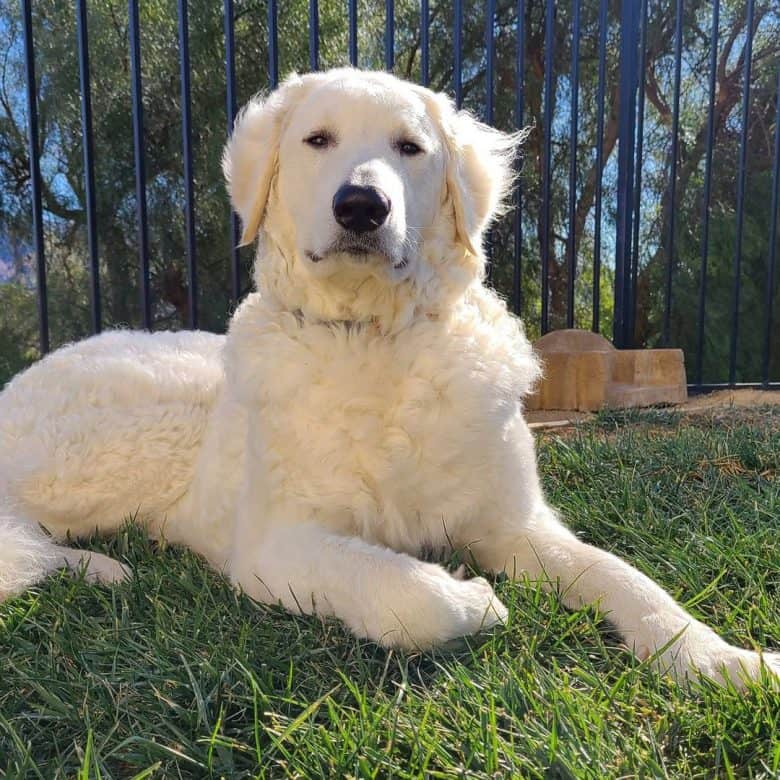
The Kuvasz has a dense, double, odorless white coat with dark skin beneath it. This physical characteristic has led to the breed being dubbed a “fashion dog”.
However, their striking white fur originally served more practical purposes rather than beauty.
This dog was bred with functionality in mind. While herding sheep, the white color allowed shepherds to distinguish their canine companions from predatory wolves. Especially those who would come out to hunt at night.
The Kuvasz’s impressive double coat consists of guard hair and a soft, fine undercoat. Short, smooth hair covers the lower forelegs and the lower hind legs, as well as its head, muzzle, ears, and paws.
A medium-length coat covers the body and sides. While the back of the thighs, tail, neck, and chest area is covered by fur up to 6 inches long.
The texture of the coat is medium-coarse and so it doesn’t have a tendency to mat. It is, however, seasonal. Meaning the Kuvasz may shed its coat during the warmer months.
It’s generally wavy but can appear straight when washed and groomed. It also repels dirt and water, making it fairly low-maintenance.
What to expect from a Hungarian Kuvasz’s temperament and personality
Their reputation of being a “one-family dog” speaks to their loyalty, devotion, and desire to protect. This makes them an excellent addition to any experienced household.
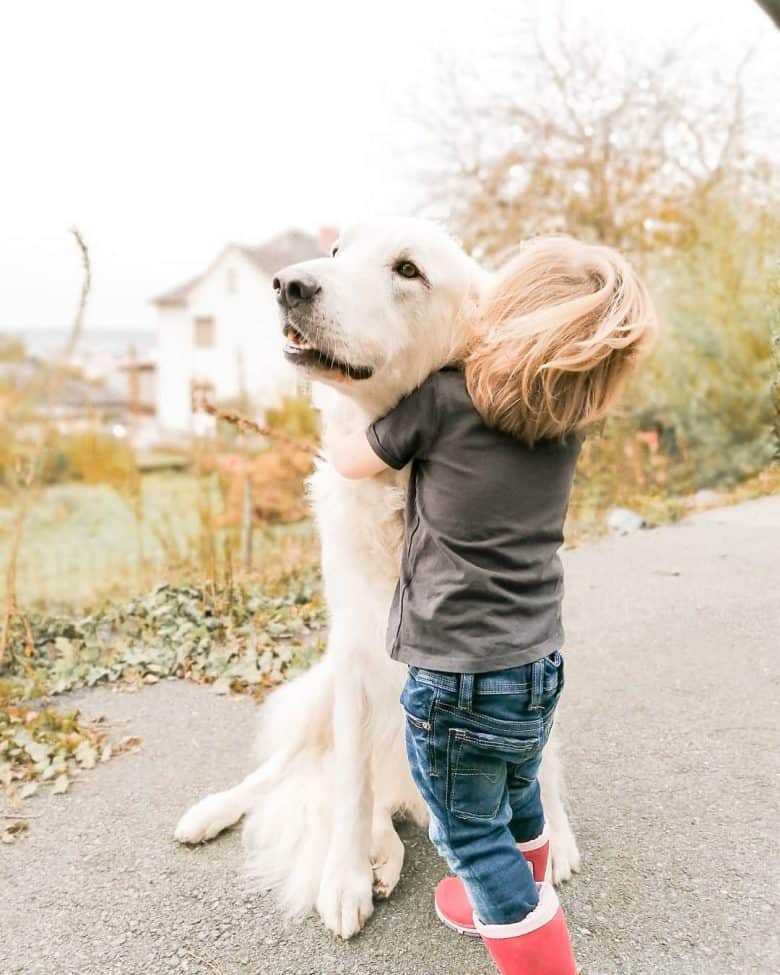
More specifically, one that can treat them with the necessary respect and commitment. They’re independent and self-determined, and so socialization and training should take top priority from a young age.
There’s a reason why they have such a strong lineage of royal watchdogs and livestock protectors. They dislike being idle and are happier and better suited to being tasked with a responsibility.
Whether it’s watching over livestock or protecting home grounds. This fearless and watchful nature makes them ideal guard dogs and protective companions.
But despite this, they’re also playful with a good sense of humor, so they know how to have fun! They can be polite with accepted strangers and other pets that they consider a part of their flock.
But it’s in their nature to be suspicious of anybody outside of the family that they protect, as their demeanor is inherently aloof.
It’s important to note that it’s not uncommon for this breed to display aggression towards strange animals.
And while they don’t have the tendency to bite or attack, they are capable of injuring anything that seems like a threat. So it’s vital that you train your dog from an early age if they are to be a family companion.
Mature Kuvasz dogs are calm, reserved, and seem to be well aware of their size and strength. Puppies should be under close supervision when playing and interacting with younger children.
Thanks to their athletic nature, Kuvaszok are skilled swimmers. They appreciate every opportunity to patrol their territory.
Whether a long walk or playtime with a friend, they should get plenty of daily exercises. These are “lone wolves” and don’t experience much separation anxiety.
Are Kuvasz dogs aggressive?
As we’ve mentioned above, with proper practice and training, this sheepdog can be well-mannered towards strangers that are welcomed by the family.
They’re a naturally friendly breed. But, as previously mentioned, Kuvasz can be aggressive to strangers, and if they are kenneled.
Like many other guard dogs, they have a strong, self-determined nature which makes them fairly difficult to train.
Kuvasz dogs make excellent companions. But they’re not recommended for first-time dog owners or those who have little to no training experience.
The process is not impossible, but experience and consistency are key! They require time, patience, and dedication from their human companions. This applies to the potty training and house-breaking process too.
How to take care of your Kuvasz
They’re generally moderate to high maintenance dogs, but one dog is different from the other.
Even with different needs, Kuvaszoks should be given plenty of shade and cool drinking water on hot days. And a warm, comfortable space during the cold weather.
If those conditions are met, Kuvaszok can be comfortable in both hot and cold environments.
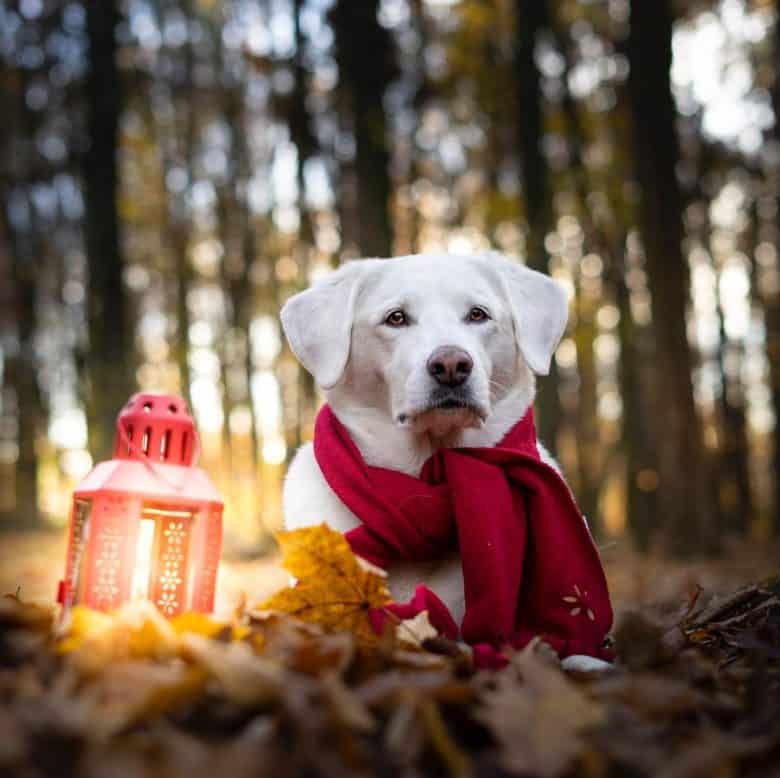
The Kuvasz needs a lot of exercises
Highly active dogs like the Kuvasz will definitely keep you on your toes.
They need someone who can accompany them for an hour of daily exercise, whether it’s a long walk through the neighborhood, a jog in the park, or even hiking.
And a breed with this energy level should have mental stimulation, as well. You can give her puzzles or interactive toys.
Getting your Kuvaszok entertained while being active is a good way to reduce aggression, as well as avoid destructive behaviors from developing.
Grooming: Do Kuvasz dogs shed?
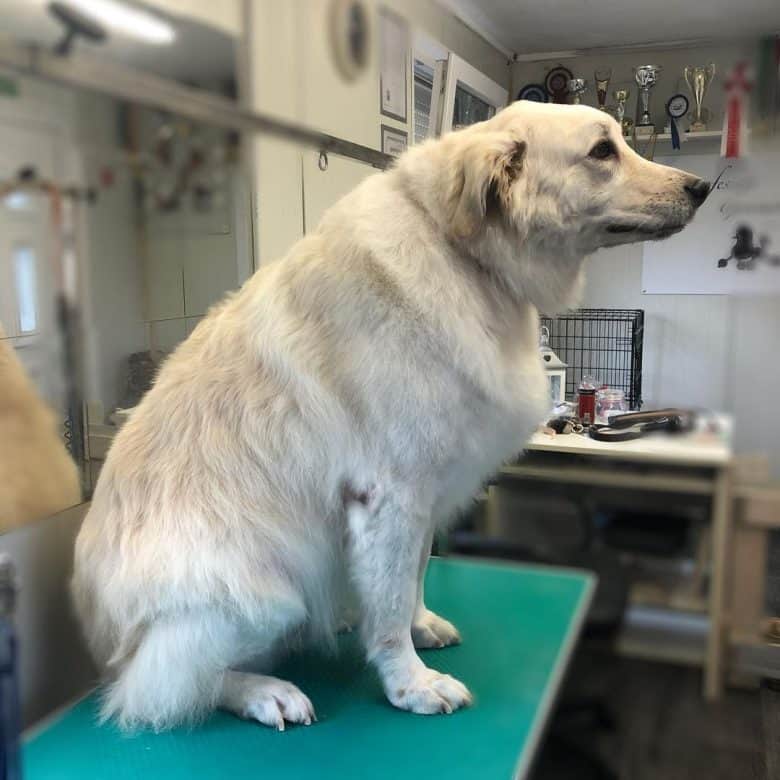
This purebred is already considered as a heavy shedder, so imagine how much fur there will be if it’s shedding season.
If you have allergies or you don’t want to deal with this much dog hair, we recommend that you look for a different breed because the Kuvasz is NOT hypoallergenic.
On the other hand, if you enjoy grooming your fur babies, then this wouldn’t be an issue. Just prepare the best vacuum you have.
Equip yourself with a pin brush, as well. You’ll be using it for your canine’s weekly brushing to remove dead hair.
Not only will it distribute the natural oils through your Kuvasz’s double coat to keep it healthy, but it will also avoid matting.
When it comes to baths, make sure you don’t do it more than once a month. Overwashing your pup will dry her fur and skin, which can lead to health problems, like allergies or rashes.
Don’t forget to inspect your dog’s eyes and ears to ensure that there is no sign of infection. Nails should be clipped to avoid splitting, especially if your pet doesn’t naturally wear them down.
For oral hygiene, brush your fido’s teeth two to three times a week. You should know that they’re average droolers, so if you don’t want your stuff covered in slobbery goo, wipe it right away.
Dog food: How much should the Kuvasz eat?
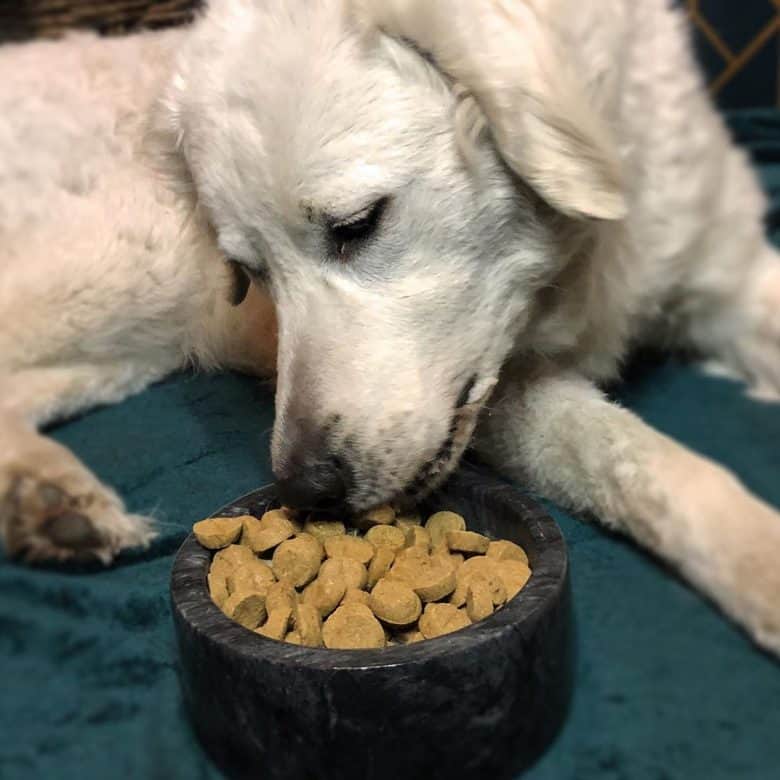
The average Kuvasz puppy should be fed 1600 calories, and 2200 calories for adults.
They need meals multiple times throughout the day depending on their age. Puppies will be fed more frequently, up to eight times a day. Older dogs will be fed twice a day.
A general rule of thumb is to remember that the Kuvasz prefers quality over quantity.
While they don’t eat according to their size, their diet should be of high-quality dog food. It should be rich in proteins and include a suitable proportion of vitamins, fats, and carbs.
Their feeding schedule varies depending on their age. Puppies need to be fed more regularly – up to four bowls a day – while fully-grown dogs need one or two bowls per day.
It’s the owner’s responsibility to adapt to the dog’s eating schedule. And ensure that they maintain a healthy appetite.
Health issues your Kuvasz may suffer from
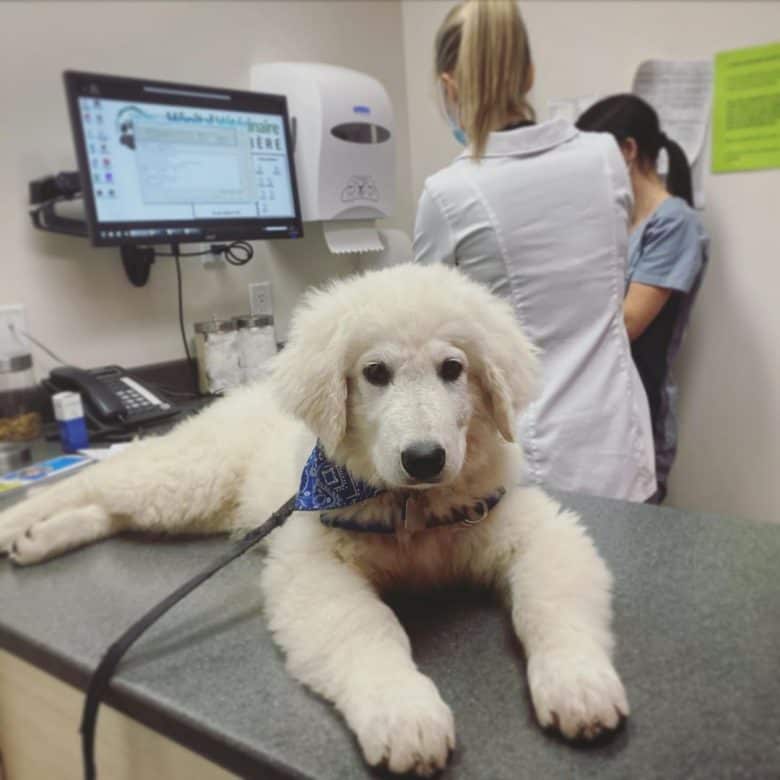
With an average life expectancy of 10 to 12 years, Kuvaszoks tend to be healthy dogs.
Still, there are health conditions that they’re predisposed to such as ear problems, canine hip dysplasia, Osteochondritis Dissecans, Von Willebrand’s Disease, and eye diseases like Progressive Retinal Atrophy (PRA).
They can also suffer from gastric dilatation-volvulus (GDC), which is simply known as bloat. You can help your doggo avoid this by serving her meals on a slow feeder.
It will stop her from gobbling up her kibbles and it can promote better digestion.
Other common health risks for this breed include:
- Hypertrophic Osteodystrophy
- Thyroid disorders
- Dental illnesses
We’re not saying that your Kuvasz will get all these diseases throughout her life, but it’s best to be aware so you can take the necessary steps to try to avoid all of them. It can even extend your canine friend’s lifespan.
How much does a Kuvasz puppy cost?
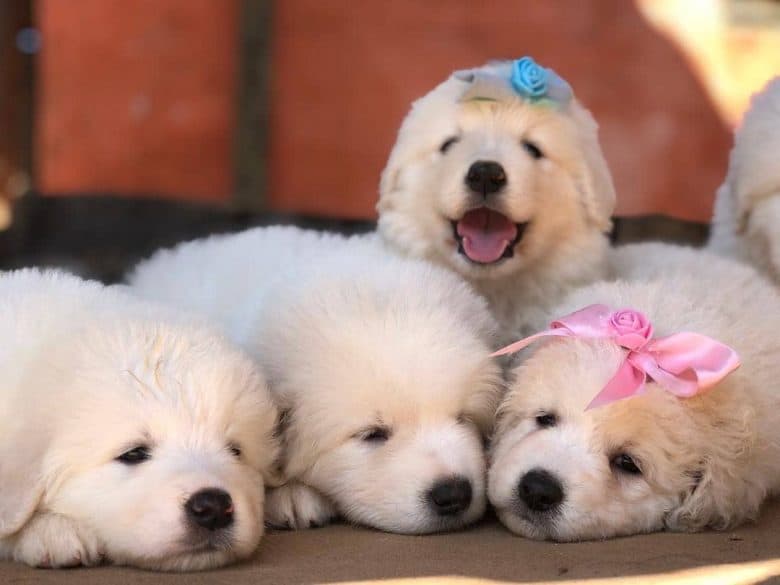
A Kuvasz puppy can cost anywhere between $1,200 and $2,000. But there are many factors to consider that can influence the price range the breeder may give you.
It can be the kennel’s popularity and location, the pup’s availability, bloodline, and even gender.
You also have to think of the annual ownership and upkeep costs, which includes dog food, training, health, and medical bills.
There’s also deworming, grooming, dental care, toys, a leash, and other supplies. You should be willing to accept these costs and commit to providing a safe and loving environment for your Kuvasz.
Finding Kuvasz breeders & kennels
Now if you’re really interested in buying a Kuvasz puppy, look for a reputable breeder. Unfortunately, it’s easier said than done.
It takes time and effort, which is something that responsible puppy sellers are looking for. They want someone who’s a perfect match for each pup.
On your end, you have to research, like see what previous clients have to say about the breeder.
Already have prospects? Request to visit the pup so you can meet the parents and littermates, as well as the place where they stay.
While you’re there, ask if you can take a look at the medical records of their breeding stock to make sure they were tested and no genetic illnesses were transferred to the puppies.
The AKC Marketplace is a good start, but here are some of the breeders online that has available Kuvasz puppies for sale:
- Aegys Kennels (Statesboro, GA)
- Casablanca Kuvasz (Northridge, CA)
- Double Ring Kuvasz (Fredericktown, MO)
The Kuvasz Club of America has a directory of breeders that’s worth looking into.
Kuvasz dogs for adoption
Adopting a Kuvasz or an older dog lets you save a fur angel and big bucks.
Opting to adopt has its pros and cons, though. Rescuing adult canines mean you won’t have to deal with so much training and the growing up years.
First-time dog owners aren’t aware of how time-consuming and costly it is to raise a puppy.
Plus, shelters make sure that their dogs are prepared to go home with their new family members. Meaning they’ve already undergone basic training.
You’ll also be sure about the looks and temperament of the pooch, and be aware of any sickness it currently has.
There aren’t a lot of rescue organizations for this breed, but we found Szumeria Kuvasz. You can also visit the Facebook page of Kuvasz Rescue and Adoption.
The Kuvasz VS Great Pyrenees
Kuvasz dogs are small in size with a medium and athletic build. So they’re agile and light-footed. They have wavy or curly white fur with no markings, which is low maintenance and easy to groom.
Due to their loyal and protective nature, trained Hungarian Kuvasz guard dogs remain within home boundaries. And if running off to chase a predator, they would generally return.
They are diligent and bark only when necessary. So they’re ideal for residential spaces with large grounds.
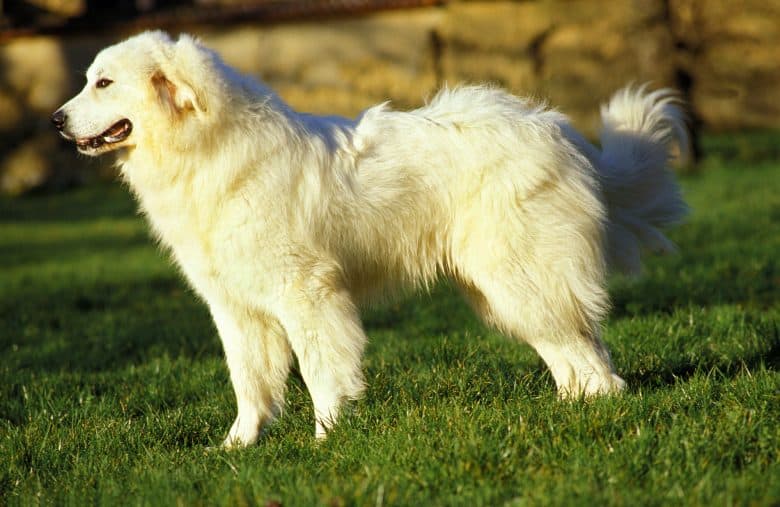
The Great Pyrenees have a larger build and are heavy boned. This makes their movement cumbersome.
Like the Hungarian Kuvasz, they also have white fur, but with gray, tan, or auburn markings on their white coat.
The hair is long, fine, straight, and has a tendency to mat. So it requires ample maintenance and plenty of patience!
They have a tendency to wander and will likely get carried away while chasing a predator. For that reason, it’s recommended that you fence them or keep them on a leash.
That is if you don’t plan on having them run away!
They’re also excessive barkers. So potential owners should keep that in mind if planning to keep them in a residential area.
Who should get a Kuvasz dog?
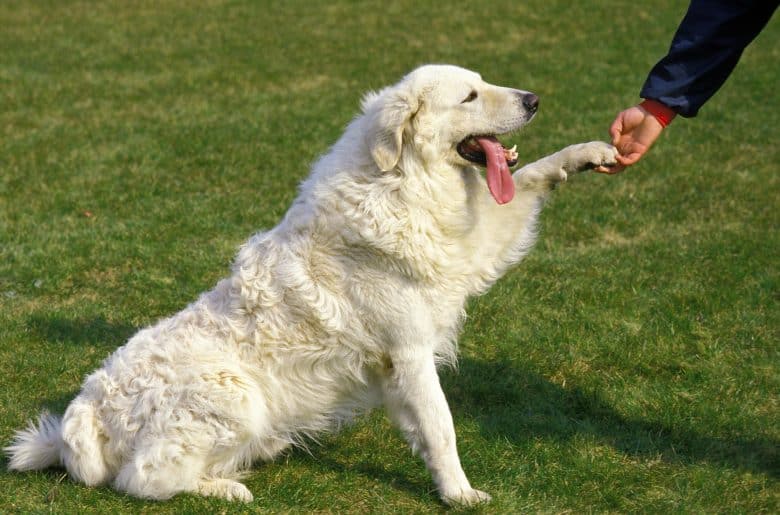
While Kuvasz dogs make excellent pets, they’re not for everybody. Like any other breed, owning a Kuvasz comes with a list of pros and cons. It’s up to you to decide whether this dog will be a good fit for you and your family.
Their independence may get the better of you, making them stubborn and difficult to train. For this reason, they’re not recommended to inexperienced dog owners.
They may do as they please and become aggressive if ‘punished’ or scolded. They’re equally sensitive to criticism as they are to praise.
They’re also heavy shedders and are not hypoallergenic. So unless you’re willing to groom and clean up after them, expect plenty of sneezing.
However, they’re smart, fierce, loyal, and determined. They are incredibly hard-working and make excellent guard dogs.
Agility and stamina make them perfect companions for active families. Or those who need an exercise buddy to keep them on track.
Plus, they have a great sense of humor and can be lots of fun around their loved ones. They don’t have very high affection levels.
But with the proper care, training, and socialization, they can make a great addition to your family.
Further reading: Similar dog breeds to Kuvasz
Maybe you enjoyed learning all about this fascinating Hungarian breed, or perhaps you need some help selecting a dog breed. Either way, you’ll likely enjoy reading about the similar breeds listed below:
Cess is the Head of Content Writing at K9 Web and a passionate dog care expert with over 5 years of experience in the Pet Industry. With a background in animal science, dog training, and behavior consulting, her hands-on experience and extensive knowledge make her a trusted source for dog owners.
When not writing or leading the K9 Web content team, Cess can be found volunteering at local shelters and participating in dog-related events.
